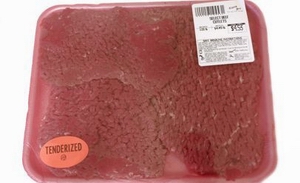 ward for the wittiest reaction to the U.S. Department of Agriculture’s plan to label such products as “mechanically tenderized top sirloin” easily goes to the industry’s powerful American Meat Institute. AMI said the proposed rule is like making Ford label “Robotically Assembled Ford Explorers.” It found the labeling changes on mechanically tenderized beef products “partially correct, but other provisions contained within it are mostly wrong.”
ward for the wittiest reaction to the U.S. Department of Agriculture’s plan to label such products as “mechanically tenderized top sirloin” easily goes to the industry’s powerful American Meat Institute. AMI said the proposed rule is like making Ford label “Robotically Assembled Ford Explorers.” It found the labeling changes on mechanically tenderized beef products “partially correct, but other provisions contained within it are mostly wrong.”Government and consumer representatives were more positive about the labeling requirements that USDA’s Food Safety and Inspection Service (FSIS) hopes to phase-in after a 60 comment period that begins with the proposals publication in the Federal Register.
“Ensuring that consumers have effective tools and information is important in helping them protect their families against foodborne illness,” said Dr. Elisabeth Hagen, USDA’s Under Secretary for Food Safety. “This proposed rule would enhance food safety by providing clear labeling of mechanically-tenderized beef products and outlining new cooking instructions so that consumers and restaurants can safely prepare these products.”
Labeling would be required for cuts of beef that go through a mechanical tenderization process using either needles or sharp blades in order to break up muscle fibers. Research and real world experience have proven that increasing tenderness by mechanical means runs the risk of pushing pathogens on the outside of the cut to the interior.
A half dozen outbreaks since 2003 are believed to have occurred because beef put through this process was not cooked to a high enough temperature for a long enough period of time.
Ami Gadhia, senior policy counsel for Consumers Union, said “We have been calling for a label for mechanically tenderized meat for years because consumers deserve to know what they’re putting in their carts and on their tables.”
“Putting a label on mechanically tenderized meat that also includes cooking instructions is a common sense step that will help protect consumers and their families from unnecessary and often serious illness,” added Gadhia.
She said Consumers Union has questions about the recommended cooking temperature, however, which is the same as that for intact steaks, and lower than that for beef patties.
“We are pleased that proposed rule has been released, and look forward to learning from USDA how they came to their cooking temperature recommendation,” she added.
“The valuable component in USDA’s new proposed rule is a requirement that these products include validated cooking instructions, “ said AMI’s Executive Vice President James H. Hodges. “We support this effort and think that safe handling labels on all products should be reviewed and improved given data showing that existing, mandatory labels have had little impact on consumer knowledge and behavior.”
“However, requiring that familiar products like ‘Sirloin Steak’ now be called ‘Mechanically Tenderized Sirloin Steak’ will lead consumers to believe that this product is new or different than those with which they are familiar. If, for example, Ford were suddenly forced to call an Explorer a ‘Robotically Assembled Ford Explorer,’ a buyer might think the car has been significantly changed, ” Hodges added.
“We would consider other labeling options that are validated through consumer research and shown to have a potentially meaningful impact on knowledge and behavior,” he continued. “For example, the product would still be called Sirloin Steak, but additional information on the package might read ‘Mechanically tenderized’ or ‘Contains enhancement solution with flavorings.’”
AMI says USDA’s data show that both types of products have excellent food safety records, but where there have been concerns, they have been almost exclusively linked to products that include an added solution.
USDA’s proposal inappropriately treats the two in identical fashion, AMI argues. In USDA’s proposed rule, the agency notes that 174 of 176 illnesses linked to tenderized products over the last decade have been linked to products that contained an added solution. During this same period, Centers for Disease Control and Prevention estimates that 480 million foodborne illnesses occurred from all foods.
“It is troubling that USDA is taking a one size fits all approach to this diverse category of products,” Hodges said. “Both types of products deliver safe, tender and flavorful products to the consumer.”
The labels would encourage both home and restaurant cooks to exercise more care when cooking these mechanically tenderized beef products and urge the use a meat thermometer to ensure an internal temperature of at least 145 degrees, plus a three-minute rest period, or even 160 degrees.
Until the new rule is phased in, between now and Jan. 1, 2016, consumers will have to ask at the meat counter if cuts are mechanically tenderized and select intact cuts if they prefer meat rare or medium rare.





